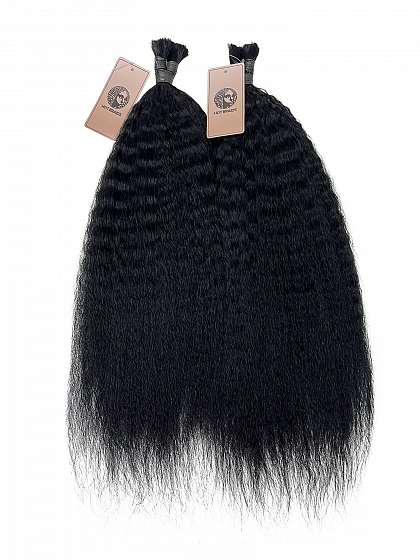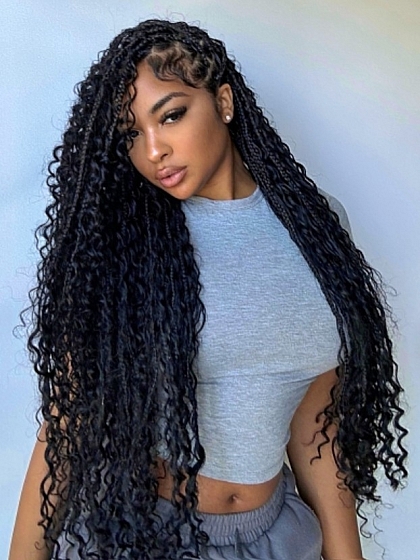Dutch Braid vs French Braid

Both Dutch braids and French braids are variations of the basic three-strand braid. Unlike cornrows, which are tightly braided directly close the scalp in in straight lines or intricate patterns, Dutch and French braids are created by gradually adding a small section of hair into each strand from the top of the scalp to the ends at the neck.
What is A French Braid?
French braids are also known as invisible braids, as they give the appearance of being seamlessly integrated into the hair. The technique used is the overhand braiding method, where the two outside strands (on either side) are braided over the middle strands. This creates a braid that lies flat against the scalp. The result is a braid that looks like it’s plait under the surface of the hair, giving it a smooth, integrated appearance.

This technique results in a braid that’s integrated into the hair, appearing as if it's under the surface of hair.
What is A Dutch Braid?
The Dutch braid uses the underhand braiding method, where the two outside strands of hair are crossed under the middle strands. This creates a braid that sits on top of the hair, giving it a raised, 3D effect. Because of this, the Dutch braid is often called the reversed French braid.

Key Differences Between Dutch Braids vs French Braids
The core distinction lies in the braiding technique and how hair is incorporated:
Braiding Technique
French Braid: Uses overhand braiding. Outside strands cross over the middle strand when adding hair.
Dutch Braid: Uses underhand braiding. Outside strands cross under the middle strand when adding hair.
Visual Result
French Braid: The braid tucks into hair,appearing seamlessly woven beneath the surface of the hair.
Dutch Braid: The braid pops outward, sitting raised on top of the hair with a 3D effect.
How to Dutch Braid?

Things you’ll need for Creating a Dutch Braid vs. French Braid:
- Comb
- Blow dryer (optional for blowout curly or kinky textured hair)
- Bobby pins
- Mini elastic rubber bands
- Braiding gel (optional for extra grip if needed)
- Braiding hair(optional for adding volume or length)
Dutch Braid Step 1:Detangle or blowout your hair
Detangle and brush out your natural hair for braiding. For curly or kinky hair, you can use a blow dryer to get a blowout for better grip,for very silky hair, mist it with some water to help with braiding.
Dutch Braid Step 2:Section your natural hair
Start by picking a small section of hair from below the hairline, in the middle front or near the temple. Divide it into three equal strands using your fingers.
Dutch Braid Step 3:Cross Outside Strands Under the Middle
Begin braiding:Take strand A (left), cross it under strand B (middle). Now A becomes the new middle.
Cross Under: Take strand C (right), cross it under the new middle (A). Now C becomes the middle.
Dutch Braid Step 4:Incorporate New Hair from scalp for Underhand Braiding
Before crossing each outer strand under:
Gather new hair from the scalp near strand A (left side)
Combine it with strand A
Cross this thickened strand UNDER the middle → it becomes the new middle B
Repeat on the right side with strand C
Dutch Braid Step 5:Keep Underhand Braiding while Adding New Hair
Repeat step 4 and keep underhand banding with new hair until you reach the nape and all of your natural hair is incorporated.
Dutch Braid Step 6: Finishing the Braid
Once you’ve incorporated all the new hair strands at the neck, complete the Dutch braid by continuing to cross the outer pieces under the middle section.
Dutch Braid Step 7:Add Volume or Length with Braiding Hair (Optional)
You can optionally add braiding hair if you desire thicker volume or longer braid length.
Dutch Braid Step 8:Secure and Retouch the Braid
Secure the Dutch Braid with mini elastic bands.
Optionally to pull pieces of the braid out to create volume and create a “butterfly” look.
How to French Braid?

French braid Step 1:Prep Hair
Detangle and brush hair thoroughly.
For curly/kinky hair:Blow-dry for smoother grip
For silky hair:Spritz with texturizing spray or water
French braid Step 2:Create Initial Section
Start by gathering a 2-3 inch section of hair below the crown as the first layer. Divide it into three equal strands: A (left), B (middle), and C (right).
French Braid Step 3:Cross Strands OVER Middle
Start braiding: Take strand A (left), cross over strand B → A becomes new middle
Cross OVER: Take strand C (right), cross over current middle → C becomes new middle
French Braid Step 4:Incorporate New Hair (Overhand)
Before crossing each outer strand over:
Gather new hair near left scalp A strand(the first braid strand hair)
Combine with strand A
Cross this section OVER middle → becomes new middle B
Repeat on right with strand C
French Braid Step 5: Continue Adding Hair from scalp for Overhand Braiding
Repeat Step 4 while moving down the head for overhand braiding.
Maintain:
Consistent section sizes
Stop when reaching the nape (all hair incorporated)
French Braid Step 6: Finish the Braid
Braid remaining length as regular 3-strand braid.
Secure with elastic bands.
French Braid Step 7: Add Braiding Hair Extensions (Optional)
For extra length/volume,gradually adding braiding hair and braid them into the your natural hair with consist tension till you finish the whole braid.
French Braid Step 8: Final Touches
Lock in: Spray with light hairspray to tame the flyaways.
For volume or fluffy look: Gently tug braid sides outward.
Cute Hairstyles for Dutch Braids vs French Braids
Dutch Braid Hairstyles:
Double Dutch Braids

Dutch Braid Pigtails

Side Dutch Braid

Dutch Braid Ponytail

Dutch loop Braids

Boho Dutch Braid Ponytail

4 Dutch Braids

Dutch Fishtail Braid

Dutch Braid Crown

French Braid Hairstyles:
2 French Braids

French Braid Bun

French Braid Ponytail

French Braid Pigtails

Fishtail French Braid

Half up Half Down French Braid

Reverse French Braid Updo

French Bubble Braids

You may also like:20 Attractive Boho Braids Hairstyles for Black Women
Reach out to us at [email protected] with any fresh braiding hair tips you've discovered or questions about hair. Enjoy your braiding and twisting journey, and keep shining!




